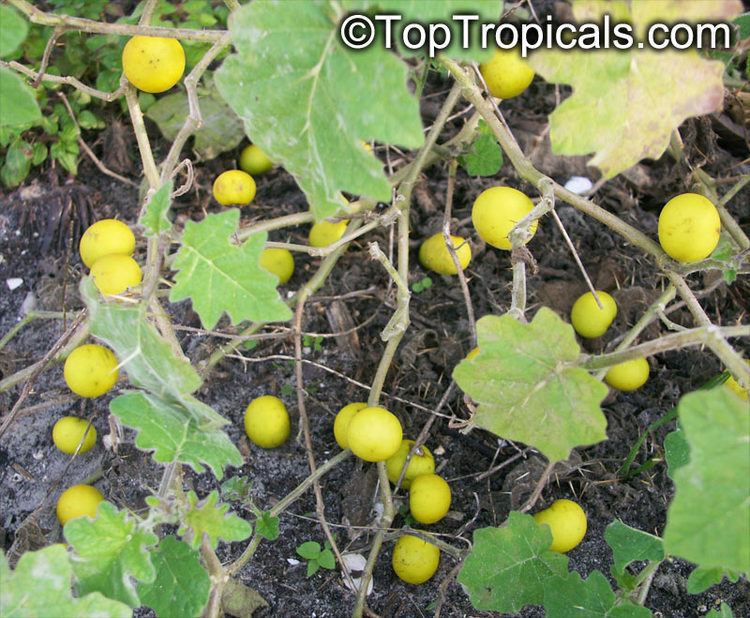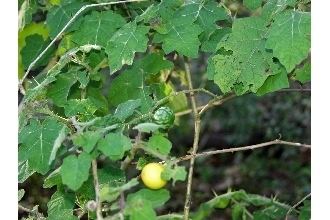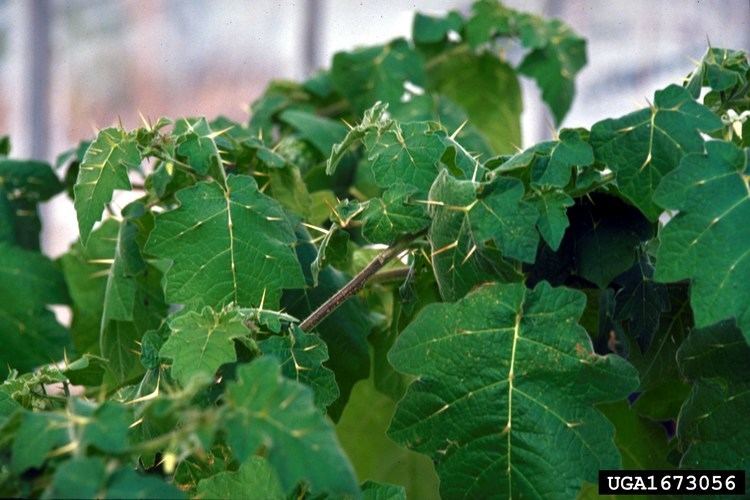Rank Species | Genus Solanum Higher classification Solanum | |
 | ||
Similar Solanum, Nightshade, Gratiana boliviana, Solanum aculeatissimum, Solanum tampicense | ||
Solvinix a novel bioherbicide for solanum viarum tropical soda apple
Solanum viarum, the tropical soda apple, is a perennial shrub native to Brazil and Argentina with a prickly stem and prickly leaves. The fruit is golf-ball-sized with the coloration of a watermelon. It is considered an invasive species in the lower eastern coastal states of the United States and recently on the Mid North Coast of Australia. Seen in the Southern Peninsula area of Cape Town as of 1 November 2014.
Contents
- Solvinix a novel bioherbicide for solanum viarum tropical soda apple
- Farm bio security for tropical soda apple solanum viarum
- Synonyms
- Ecology
- General Information
- References

Farm bio security for tropical soda apple solanum viarum
Synonyms
This species has several synonyms, one of which is particularly ambiguous:

Ecology

The tropical soda apple leaf beetle (Gratiana boliviana) has been used successfully as an agent of biological pest control to reduce the abundance of this plant in the United States, particularly in Florida.
General Information
Native To: Brazil and Argentina.
Date of U.S. Introduction: First discovered in 1988
Means of Introduction: Probably through contaminated seed or other agricultural products
Impact: Crowds out native species and forage for livestock
Habitat: Terrestrial; fields, rights-of-way, open forest

Regulations: It is a state Noxious weed in Florida and Mississippi and a state Noxious plant in Texas. Tropical soda apple is a Class A Noxious weed in Alabama, North Carolina, and Vermont. In California and Oregon, it is a Quarantine pest. It is a Prohibited Noxious weed in Arizona and Minnesota, Prohibited in Massachusetts, and a Plant Pest in South Carolina and Tennessee.

Flowering- The mature fruits are smooth, round, yellow and ¾ to 1 ¼ inches in diameter with a leathery-skin surrounding a thin-layered, pale green, scented pulp and 180 to 420 flattened, reddish brown seeds. Each plant is capable of producing 200 or more fruit per year. Tropical Soda Apple (Solanum viarum) usually grows to 3–6 ft tall.
Spread By: Tropical soda apple is spread by livestock and wildlife, such as raccoons, deer, feral hogs, and birds feeding on fruits. Since its introduction into the U.S., tropical soda apple has spread rapidly, and currently infests an estimated one million acres of improved pastures, citrus groves, sugarcane fields, ditches, vegetable crops, sod farms, forestlands (oak hammocks and cypress heads), natural areas, etc. in Alabama, Florida, Georgia, and Mississippi. Although it can be a threat to a variety of habitat, it tends to be most problematic in pastures in the Mid South.
Control: Triclopyr herbicide; Milestone is 5–7 oz/A.; Biological herbicide. A natural, biological herbicide to control TSA is currently under development and is not available for public use at this time. The product is called SolviNix™. TSA beetle. A beetle known as Gratiana boliviana (TSA beetle) has been investigated over the past several years for control of TSA plants. This beetle is native to South America and underwent a rigorous quarantine process prior to its release in 2003.
